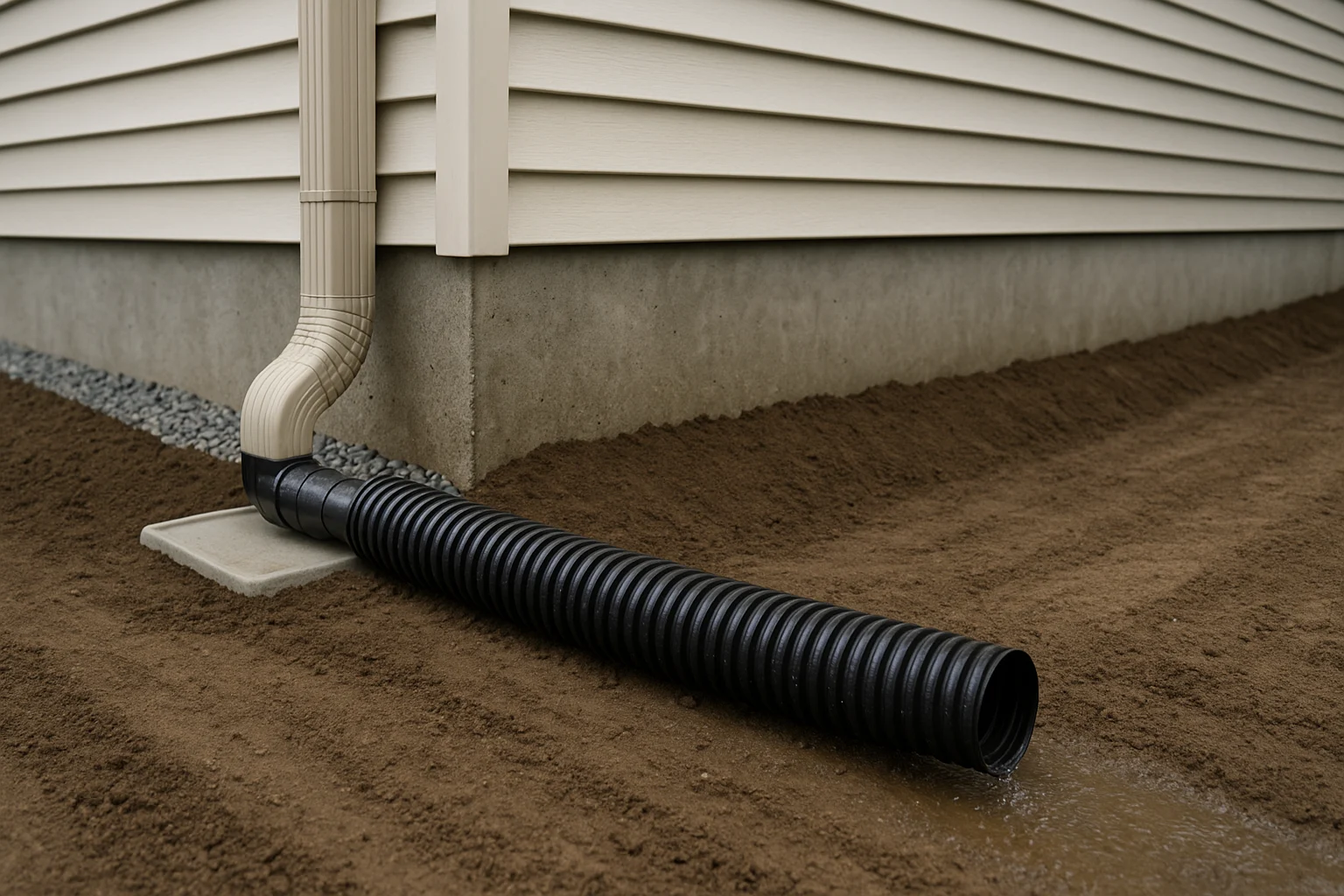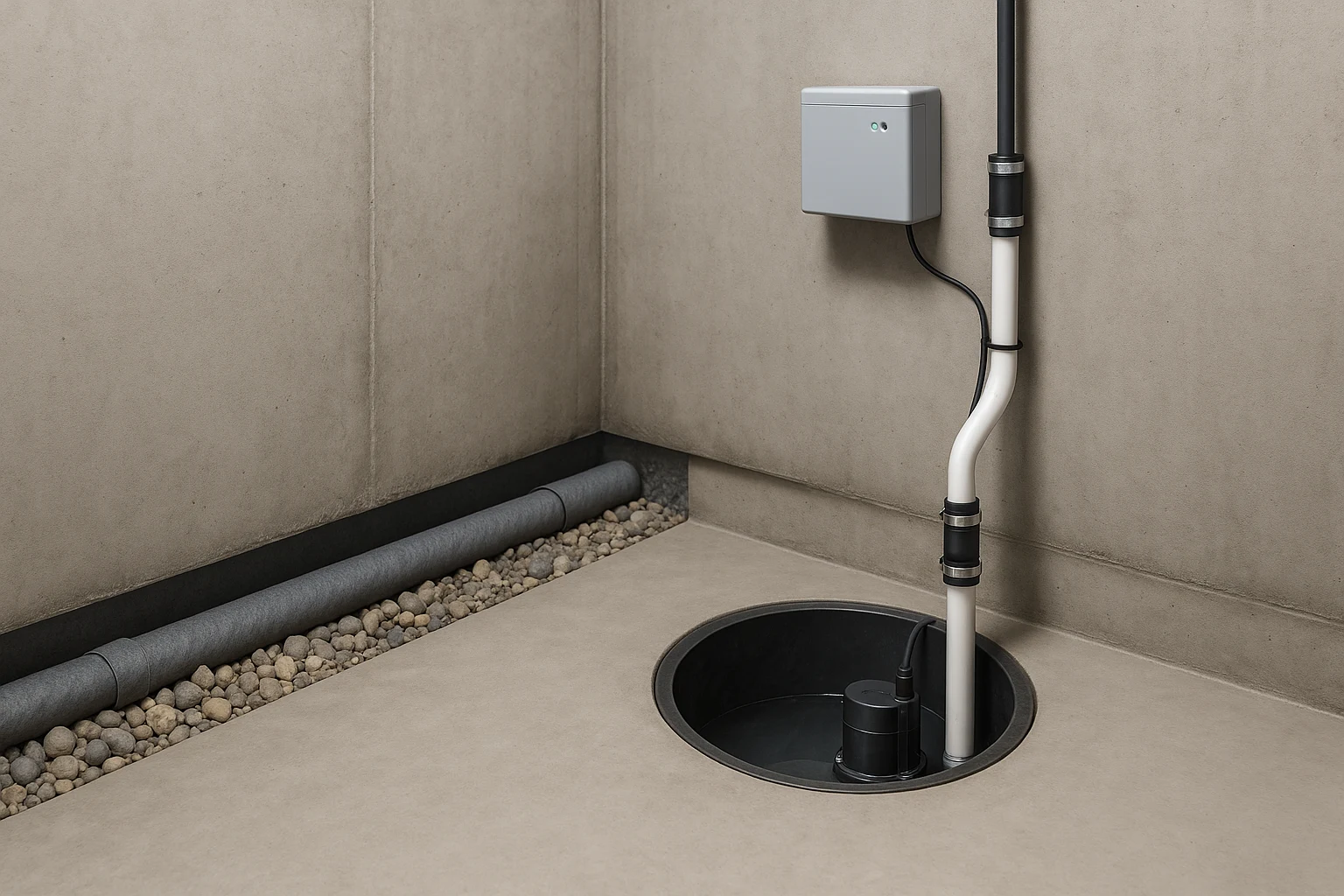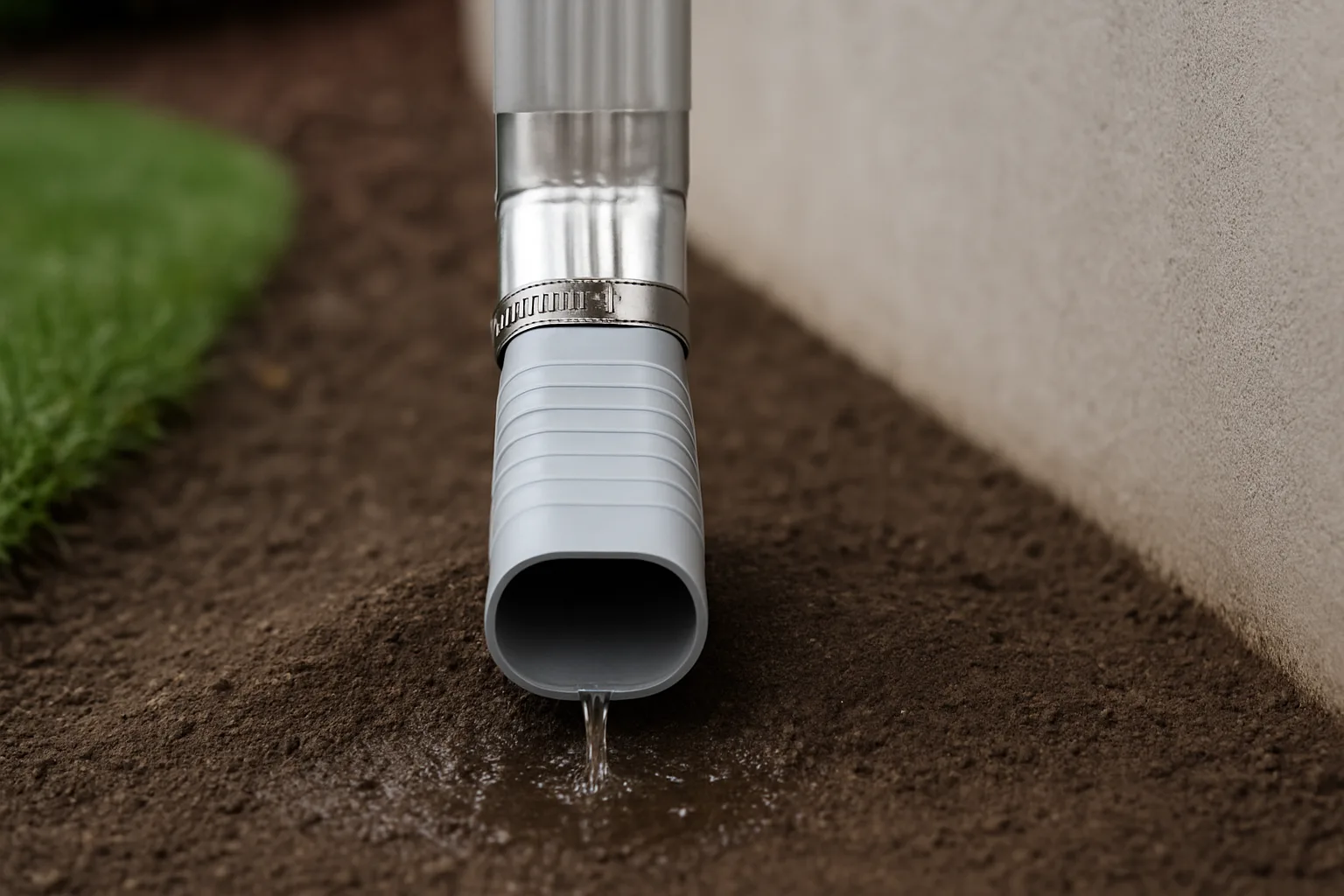
If your basement smells musty or shows faint salt rings, you’re not alone. With DIY basement waterproofing, you’ll zero in on the cause and pick the right fix—starting outside with gutters, downspouts, and grading, then tackling cracks, coatings, vapor barriers, and sump pumps as needed. We’ll also call out the red flags that mean it’s time to bring in a pro. For broader incentives that can reduce project costs, see our guide to energy efficient home improvement credits.
Basement Fix Finder
Answer a few quick questions to get your best first steps.
If you learn best by watching, scan basement waterproofing youtube tutorials to see the flow—then follow manufacturer instructions for final installation details.
Table of Contents
Key Takeaways
- Identify Problems Early: Regularly inspect your basement for signs of moisture like cracks, efflorescence, and musty smells to catch issues before they worsen.
- Prioritize Exterior Drainage: Most fixes start outside the home: clean gutters, extend downspouts, and make sure the soil slopes away from the foundation.
- Seal Cracks and Gaps: Small foundation cracks and gaps around pipes are common entry points for water and can often be sealed with hydraulic cement or epoxy.
- Apply Interior Waterproof Coatings: Waterproof paints and sealants can help manage surface dampness and condensation, creating a protective barrier on interior walls.
- Know When to Call a Pro: For persistent flooding, major structural cracks, or complex exterior excavation, consulting a professional waterproofing expert is crucial for long-term solutions.
Why Basements Get Wet
Before you can fix a problem, you need to understand what’s causing it. Basements are naturally prone to moisture issues because they are built below ground level, constantly surrounded by soil that can hold water. Here are the main reasons why basements get wet:
- Hydrostatic Pressure: Water in soil presses against walls and floors and can force its way through weak points.
- Cracks in the Foundation: Settling, soil movement, and temperature swings create pathways for water.
- Poor Exterior Drainage: The most common culprit.
- Clogged Gutters and Downspouts: Overflowing water pools near the foundation and seeps inside.
- Improper Grading: Soil should slope away at least 6 inches over the first 10 feet.
- Sump Pump Failure: Power loss or mechanical issues can lead to flooding.
- Condensation: Warm humid air on cool surfaces mimics leaks and fuels mold; improving window insulation can reduce cold-surface moisture.
- Leaking Pipes or Appliances: Internal sources can add to the mess.
Signs You Have a Basement Moisture Problem
- Musty Odors: Often signals hidden mold.
- Visible Mold or Mildew: Black, green, or white growth on surfaces.
- Efflorescence: White, powdery mineral salts on masonry.
- Water Stains: Discoloration on walls, floors, or ceilings.
- Peeling Paint or Wallpaper: Moisture behind finishes causes bubbling and failure.
- Damp or Wet Spots: Cool, moist patches on walls or floors.
- Standing Water: A clear sign of a serious leak.
- Rust on Metal: High humidity corrodes tools and fixtures.
DIY Basement Waterproofing: Interior vs. Exterior Fixes
For most DIY basement waterproofing plans, start outside; interior methods manage water that gets in, while exterior work blocks it at the source. Each has trade-offs in cost, disruption, and effectiveness.
Decision mini-guide: If you’re tackling a basement waterproofing DIY project, choose by symptom: Condensation or light damp + efflorescence → dehumidifier, interior coatings, and crack sealing. Seepage at the cove joint after rain → interior French drain tied to a sump pump. Puddles near the foundation, overflowing gutters, or negative grading → extend downspouts 5–10 ft and regrade 6 in over 10 ft. Horizontal/bowing cracks, repeated flooding, or a high water table → get a pro assessment. Start outside; escalate inside only as needed.
Symptom → Fix cheat sheet: Quick wins: Clean gutters; repair leaks; add splash blocks; extend downspouts 5–10 ft. Regrade soil to fall 6 in over the first 10 ft. Seal hairline cracks with hydraulic cement; inject wider structural cracks with epoxy. Roll on waterproof masonry coating to dry, prepped walls. Add a 6-mil vapor barrier behind finishes. Test the sump pump and add a battery backup for storms.
This post contains affiliate links. If you buy through our links, we may earn a commission at no extra cost to you. Learn more.
Interior Methods
Pros: Lower cost, DIY-friendly, yard stays intact—ideal for basement DIY waterproofing where you’re managing light damp and small cracks. Cons: Doesn’t stop water from entering the wall; can be a band-aid for heavy pressure.
- Crack Sealants: Hydraulic cement, epoxy/PU injection.
- Waterproof Coatings/Paints: Blocks surface dampness on interior walls.
- Vapor Barriers: Poly sheeting to control condensation and wicking—often paired with wall insulation DIY.
- Interior French Drains & Sumps: Channels water to a pump for discharge.
If you’re working out how to waterproof basement from inside, the most durable approach for waterproofing basement walls from inside diy is layered: crack repair, a masonry coating (compare guides that discuss the best waterproofing basement paint), and a continuous vapor barrier. That’s the core of diy waterproofing basement walls and mirrors what many diy basement waterproofing systems recommend; choose a DIY kit only after exterior drainage is corrected and seepage is mild. Before you choose products, sketch out how to waterproof your basement walls step by step so surface prep doesn’t get skipped.
DIY Exterior Basement Waterproofing Methods
- Improve Grading: Slope soil away from the house.
- Gutters & Downspouts: Clean, repair, extend.
- Exterior Coatings/Membranes: Applied after excavation.
- Exterior French Drains: Diverts groundwater before it hits the wall.
Homeowners attempting diy basement waterproofing from outside or waterproofing basement walls from outside diy should plan for excavation, careful membrane detailing, and drainage upgrades—work that can be labor-intensive and risky near utilities, so consider permits and call 811 where applicable.
Diagnose & Fix Steps
1) Inspection & Problem ID
- Check walls/floor for cracks, stains, efflorescence; sniff for musty air.
- Use a hygrometer; >60% suggests condensation risk. Try the foil “tape test.”
- Outside: gutters, downspouts (extend 5–10 ft), grading, window wells, vegetation near foundation.
💡 A careful walk-through is the foundation of good DIY results. Give yourself ten focused minutes—you’ll save hours later.
2) Crack Repair
For small seepage at a single joint, diy basement leak repair kits with epoxy or polyurethane injection can help; for minor spalling or mortar joints, start with diy basement wall repair before any coating.
3) Waterproof Coatings & Sealants
Prep is everything: clean, repair, and let walls dry before you roll anything on. Most coatings need two coats—and a little patience for curing and ventilation.
4) Interior Vapor Barriers
Use 6-mil poly, overlap and tape seams, and protect with furring strips before finishes—pair with DIY spray foam insulation at rim joists for better air sealing.
5) Sump Pumps & Interior Drains

For seepage or pooling, tie a perimeter drain to a sump pit. Add a battery backup to cover storm outages, and improve humidity control with duct sealing.
6) Exterior Drainage Tune-Up

- Clean gutters regularly; repair leaks; add splash blocks.
- Regrade to drop 6 in over 10 ft; mind sill plates and brick weeps.
- Maintain window wells with covers and gravel bases.
Costs & Money-Saving Tips
- If you’re asking how much does it cost to waterproof a basement, the honest answer is that it depends on scope—then start with prevention: downspouts, grading, and crack sealing are low-cost, high impact.
- DIY labor saves most; rent heavy tools; buy soil/gravel in bulk when needed—and consider attic insulation DIY to reduce moisture migration and energy costs.
- Compare prices on hydraulic cement, coatings, caulk, and poly sheeting.
- Focus on root causes, not symptoms, to avoid repeat fixes.
- To benchmark pricing, search waterproofing basement walls cost locally and compare against your materials list and any contractor quotes.
When to Call a Pro
- Major structural cracks or bowing walls: Get a structural engineer and foundation specialist.
- Persistent flooding/high water table: Professional-grade drainage needed.
- Extensive excavation: Exterior drains and membranes are pro territory.
- Widespread mold (>10 sq ft): Hire remediation; see EPA mold guidance for safety basics.
- Can’t find the source: Pros use moisture meters and thermal imaging.
Your Basement Waterproofing Checklist
- Inspect gutters and downspouts for clogs and proper extension (5–10 ft).
- Verify ground grading slopes away from the foundation (6 in over 10 ft).
- Seal hairline cracks with hydraulic cement or masonry caulk.
- Repair wider or structural cracks with an epoxy injection kit.
- Apply waterproof masonry coating to clean, dry interior walls.
- Install a 6-mil interior vapor barrier if condensation/dampness persists.
- Test the sump pump and consider a battery backup.
- Clear window wells; add covers and ensure proper drainage.
- Monitor for musty odors, mold, or efflorescence after storms.
Frequently Asked Questions
Conclusion
A dry basement protects your home’s structure, air quality, and storage. Start with exterior drainage, seal obvious entry points, and apply interior defenses where appropriate. Escalate to interior drains and pumps only as symptoms demand—and bring in a pro for structural or chronic issues.
This guide is educational and general in nature. It is not engineering, building-code, tax, or legal advice. Always follow local codes and safety practices, use appropriate PPE, and consult qualified pros for structural issues, persistent flooding, or mold over 10 sq ft.